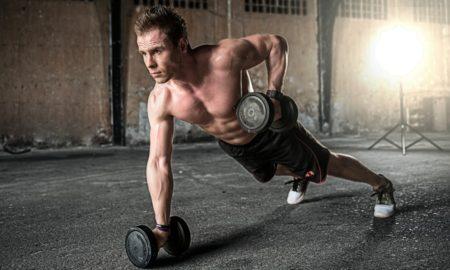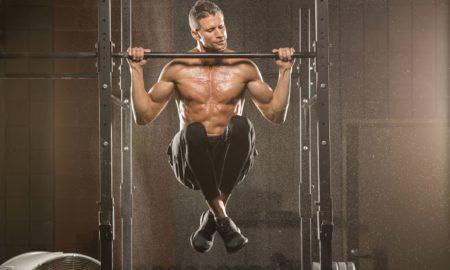One of the pleasures of training at Gold’s Gym in Venice, California, is the stimulating atmosphere, with bodybuilders from all over the world working out side by side and exchanging information.
During a lull in one of my workouts there recently I was approached by a well-developed young bodybuilder who wanted to ask ‘just one question’ (which is something no aspiring bodybuilder can possibly do). His one question, of course, led to a lengthy catechism, but I didn’t mind, as his queries were intelligent and thought-provoking. As we continued our conversation, my interrogator told me he had attended the seminars of practically every top bodybuilder in the world back home in Toronto. He claimed that even though he did pick up some valuable practical information from a couple of champions, in most cases he left the seminars disappointed. Often contradictory information was dispensed and sometimes even misinformation.
Like what?’ I asked.
Why, Mike, that’s easy,’ he shot back. ‘There are so many. Just recently one of the greatest bodybuilders of all time held a seminar in our gym and said something to the effect that to create definition in the frontal thighs, you shouldn’t perform squats, as they ruin definition, and that leg extensions were best.’
‘Okay, he was wrong,’ I replied. ‘Did you call him on it?’
Yeah, I told him that there was no such thing as a definition exercise or a bulk exercise. I said that because squats activate more muscles, they burn more calories than extensions and will therefore enhance definition faster.’
What did the champ say then?’ I asked.
Before he could respond, someone in the audience yelled that I was crazy and wanted to know how many titles I had won. The champ then pointed out that he had many more years’ experience than me and was obviously more successful. I realized that his seminar was not intended as an open exchange of ideas but a monologue by an egomaniac, so I shut up.’
I told the young bodybuilder that he had done well in questioning the champ but that it was probably best not to push the point and resumed my workout. However, the attitude typified by the young bodybuilder is one that’s becoming increasingly prevalent among strength athletes all over the world. Everywhere truth-seekers are taking a hard critical look at traditional training and dietary practices. No longer do they automatically swallow the advice of a top champ. No longer will they passively bow to the decree, ‘Thou shalt!’ They want a reason, a rationale, some supportive facts. They want to know why. Some bodybuilding traditionalists are growing increasingly alarmed as they witness their rumpus-room picture of bodybuilding systematically slashed by the sport’s medical specialists, exercise physiologists, nutritionists and aspiring bodybuilders.
It’s no wonder that the young, questioning bodybuilder of today is often confused by the welter of conflicting opinions regarding sets, reps, how often to train and which system to use. For years now the different magazines have been teeming with articles that proffer contradictory opinions on precisely what is the best way to train. Adding to the bodybuilder’s dilemma now is the raging controversy between the advocates of free weights and those who sing the praises of the machine.
Although there has been a massive proliferation of exercise machines on the market’Nautilus, Bowflex, Universal, Hammer Strength, Bodymasters and Cybex, to mention some of the more prominent ones’the epicenter of the storm for years has been Nautilus. That’s due in part to the fact that Nautilus was the first (perhaps the only) machine manufacturer that actually conducted its own large-scale research in sportsmedicine and exercise physiology and turned out reams of copy on its results, much of which ran contrary to the prevailing world view. Another reason Nautilus was the subject of so much controversy probably had to do with its rise as the leading manufacturer of exercise equipment, with sales in 1981, the year in which it received the most heat from the bodybuilding establishment, reportedly in the neighborhood of $350 million.
It’s important for bodybuilders struggling to arrive at some understanding of the controversy to realize that the prejudice of the people involved is a strange one indeed but a very real one that must be considered. A biased selection and a distorted representation of statistics are often adduced to prove points that are the opposite of the truth. Most of what has been written about the various modes of training comes from the equipment manufacturers themselves, which makes it suspect. I’m not really interested in proving anyone right or wrong. Such an approach would point to a bias on my part, making my viewpoint just as suspect. What I am interested in is an objective look at the facts as they exist so that the bodybuilder can make his own enlightened decision as to which mode works best.
A bodybuilder will reach a reasonable conclusion only if he can examine the various points of controversy with adequate information. The following discussion should help him develop his own conclusions.
Free Weights: Pro and Con. Before Alan Calvert developed the plate-loading barbell, around the turn of the century, bodybuilders and strength athletes, as we know them today, didn’t exist. It’s obvious that the barbell produced muscular size that was impossible to achieve before its appearance. Compared to anything that came before it, the barbell was a miracle implement. The fact that the barbell is a productive tool’when used properly’cannot be denied, as the vast majority of today’s champion bodybuilders and strength athletes were weaned on it. That doesn’t alter the fact that the barbell has certain shortcomings.
For a proper understanding of the shortcomings of a barbell we must take a look at the basic underlying effective training methodology. While our various bodyparts move in a rotary fashion about an axis, most conventional free-weight equipment provides only ‘straight-line,’ or unidirectional resistance. That accounts for the fact that in most exercises the weight feels heavier in some positions than in others, and very rarely is there any resistance at all in the peak, or fully contracted, position, the only position where 100 percent of the individual muscle fibers can be activated.
For example, the curl, a movement that is rotational through a range of some 160 degrees, provides effective resistance only through a very small area of its range of motion. Only at that point in the curl where the forearms are perfectly parallel to the ground, where gravity is pulling the weight straight down and you are pulling it straight up, is the resistance direct. Once the weight passes through that point, the effective resistance falls off and the weight feels light, with little or no resistance in the contracted position.
In those barbell exercises on which you can lock out and hold the weight in the peak contracted position, there’s no resistance to force contraction. That’s a major drawback of the barbell, since again, the contracted position is so important for growth stimulation. Examples of barbell exercises where lockouts occur are squats, presses of any sort and curls. In the lockout all effective resistance has been removed from the muscle and the weight is being supported by the bones, which are in a straight-line position. When this happens, the muscles can relax, and, since there is no resistance for them to fight against, there is limited growth stimulation.
The existence of a sticking point’that point in an exercise where the resistance is heavier than at other points’makes it clear that the muscles are being worked harder in some positions than others. A lockout, or a position where the weight can be supported with little or no muscular involvement, points to the fact that sometimes the muscles are not being worked at all. All this demonstrates that barbell exercises provide resistance for the muscles only in their weakest positions and add little or no resistance in their strongest positions. Since everyone is aware that resistance and intensity are the factors that cause growth stimulation, it should be perfectly obvious that where no resistance occurs, there can be little growth stimulation’and in most barbell exercises that is just the situation we find in the peak contracted position of the muscles. There are exercises that are productive in spite of these limiting factors, though not nearly as effective as they would be without them.
Exercise Machines: Pro and Con. If an exercise machine does not provide advantages that more than compensate for its inherent disadvantages, then you’re better off sticking with free weights. And considering the inherent disadvantages of most exercise machines, one would have to conclude that most of them’though not necessarily all’are actually less productive than the barbell. Following are some of the oft-cited advantages and disadvantages of the exercise machine:
Mechanical specificity, or ‘guided resistance.’ The one disadvantage inherent to all exercise machines is this factor of guided resistance. The resistance provided by exercise machines is limited to a single ‘track of movement,’ unlike the barbell, which allows freedom of movement in any direction. Because certain barbell exercises can approximate the mechanics of certain movements found in different athletic events, such as the shot put and jump-related activities, they can be used to enhance performance in those events. Bodybuilders trying to work specific areas of a muscle can do so with barbells by altering the angle of resistance. Machines do not allow this because of the restricted single track of movement.
Reverse geometry. As mentioned previously, barbells provide resistance in only one direction’down, as a result of gravity. By using pulleys, you can redirect resistance in any direction, but even in such cases the resistance still occurs in only one direction; that is, it’s unidirectional. What you end up with is an exercise that’s almost identical to a barbell exercise and in some cases is less effective. Machines that work muscles that cannot be worked by a barbell are certainly justified. Examples of worthwhile applications of redirected barbell exercises are the lat machine and the leg press machine.
The so-called variable resistance machines’Nautilus being the best known’have attempted to increase available resistance throughout the entire range of motion in order to overcome the shortcomings of the barbell. Nautilus has provided for automatically variable resistance that corresponds to the strength curve of the muscle through its full range of motion by means of an offset cam. And while the Nautilus cam may not provide the perfectly balanced resistance that the manufacturer claims, it is highly probable that it comes closer to being more perfectly balanced than the unidirectional resistance provided by barbells and the resistance of reverse geometry provided by some of the other machines on the market.
Power output. It has been suggested that machines do not permit very rapid movements and therefore do not permit the development of power, which is important to the bodybuilder trying to become more massive. It is true that Nautilus has gone on record repeatedly, stating that all exercise movements should be performed deliberately and under control to obviate the very real possibility that momentum might aid in completing the movement and thus reduce power output and intensity, not to mention the fact that deliberate motion makes any exercise safer. What is not true is that the movements cannot be performed rapidly. The fact is that, although such a practice is usually both unproductive and unsafe, you can perform rapid movements on machines.
Direct exercise. I have already mentioned the fact that barbells do not provide direct resistance because they provide only straight-line, or unidirectional, resistance to bodyparts that move in a rotary fashion and are thus constantly changing the direction in which they move. Because of this, the weight will feel heavier in some positions and lighter in others, often with no resistance at all in the important peak contracted position. As far as I know, Nautilus and Hammer Strength are the only machine manufacturers that have endeavored to overcome this short-coming by providing resistance that is directly opposed to the movement, or 180 degrees out of phase with the movement. Whether they succeeded is debatable.
The preceding considers only one of the two distinct meanings of the word direct in its application to exercise. Direct in the other sense means the resistance must be applied against the prime mover, or the bodypart moved by the involved muscles. In this sense Nautilus has provided direct exercise by designing machines that place the source of resistance against the prime mover. In the case of the latissimus, the Nautilus pullover machine applies the resistance against the prime mover, the upper arm, instead of against the forearm and hand, as is the case with all other conventional machine or free-weight exercises. As explained in the Heavy Duty installment in the February ’03 IRONMAN regarding the preexhaust principle, any lat exercise that applies resistance to the forearms creates a ‘weak link’ owing to a lack of proportionate strength in the upper arms. The lats never reach a point of true muscular failure because the upper arms fail first.
A Synthesis. Individuals who have spent enormous amounts of time, energy and money selling a particular idea or product often become so intent on seeing their creation accepted by others that they tend to lose their objectivity. This blindness has afflicted the inventors, manufacturers and purveyors of free weights and machines and has even affected the philosophies (if you can call them that) behind each. The stakes are no longer just commercial/financial but in some manner intellectual/philosophical.
The advocates of free weights point to the fact that the vast majority of bodybuilding and strength athletes have trained on free weights. Their stand is not entirely valid, since all the failures have as well. Those who push machines are just as blind in their exaggerated claims that the devices will produce results unheard of with free weights. The tactics used by each side in selling its products have focused so much on the relatively small differences between them that they’ve lost sight of the fundamental similarities.
Free weights and machines are both progressive-resistance tools that must adhere to the basic high-intensity principles of progression and intensity if they are to work for anyone. Machines are not that different from free weights. No matter which the bodybuilder decides to use, he must move a certain resistance a certain distance in a certain time. Whether he uses free weights, machines or cinder blocks, he will get larger and stronger only by progressively increasing the level of resistance.
Recognizing that free weights and machines each have their strengths and weaknesses, would it not be more rational to discover the strong points of each and fuse them than continue to focus on their shortcomings? As bodybuilding is my vocation, I have investigated the strengths and weaknesses of free weights and machines as objectively as possible. My ongoing research has led me to formulate a tentative conclusion as to how the bodybuilder can best utilize the two modes in combination that is based on an application of the high-intensity principles of adaptation and specificity, according to the needs, respectively, of the beginning, intermediate and advanced bodybuilder.
The beginner, for instance, must develop neuromuscular coordination, overall strength and conditioning, along with an appreciation of the kinesthetic pleasure to be derived from weight training. While Universal, Nautilus, Hammer Strength and the other machines can develop overall strength and improve condition, they don’t allow the freedom of movement required to work the mass of muscles in a single motion or develop the base of power and neuromuscular coordination. The beginner should not be concerned with developing a highly refined appearance. A solid foundation must be built first. Barbells and free weights are better suited for this, as more muscles under greater resistance can be brought into play. An example is the barbell clean and press, which brings into play practically every muscle of the body in one unified coordinated action, thereby developing great overall power and neuromuscular control. The guided resistance provided by machines is too restrictive and works the muscles more in an isolation manner, though a few do work some accessory muscles.
This kind of compound movement performed with a barbell is much better for creating overall mass and power than the isolation movements provided by most machines. When I was a youngster of about 16 and was stuck at 200 pounds on the military press, I was able to press 210 or sometimes even 215 with the help of a slight shove from my traps, hips and waist. Getting the heavier weight overhead and then lowering it under control brought in more muscle fibers and developed my confidence. Doing strict presses would have kept me stuck at the same weight for weeks. The freedom of movement allowed by free weights can be used to teach the beginning bodybuilder to marshal his strength in a specific area and release it explosively for the handling of heavier weights. Free weights also provide the psychological satisfaction gained in seeing and feeling a heavier weight than usual and in overcoming an obstacle. This visual feedback is the fuel that motivates the bodybuilder to continue. Most machines don’t provide this important feedback, and the less resolute beginner can become bored and quit.
As the beginner continues to train regularly, using the basic exercises, he develops a solid foundation of power, mass and familiarity with his functional capacities.
The intermediate bodybuilder’one who has been engaged in regular training with free weights for upwards of six months to a year’should begin focusing his attention on the development of individual bodyparts and controlling them with his will as a means of refining their appearance. At this point the bodybuilder can also focus on his weak points, as not all bodyparts grow evenly’specialization at this time is important for maintaining balance and symmetry. The intermediate would do well to use machines about 25 percent of the time in his training.
The advanced (i.e., competitive) bodybuilder zooming in on a contest can use all types of equipment, including machines, cables and free weights. The machine exercises along with all forms of dipping and chinning will be useful in helping him further chisel his muscles and sharpen his definition, in addition to overcoming his weak points. In this way he can still use the free weights for chiseling and maintaining mass as well as relying on the machines for further refinement and balance. The more advanced bodybuilder is still well advised to train predominantly with free weights in the off-season in his continuing quest for mass. Machines are great, especially as adjuncts during the precontest phase for that look of ultimate refinement.
In closing, I’d like to emphasize that, while free weights and machines are capable of working wonders in their respective ways, neither is magic, and only total dedication and sustained effort over a period of time can produce optimal results. So, as the bodybuilder grows in experience, he may formulate his own mode of training based on what he decides best suits his needs at any given time. Whatever you decide, I hope your decision is made after you have objectively assessed the available information.
Editor’s note: For more information on the teachings of Mike Mentzer, visit www.mike mentzer.com or order any of the Heavy Duty books from Home-Gym.com. IM




















You must be logged in to post a comment Login